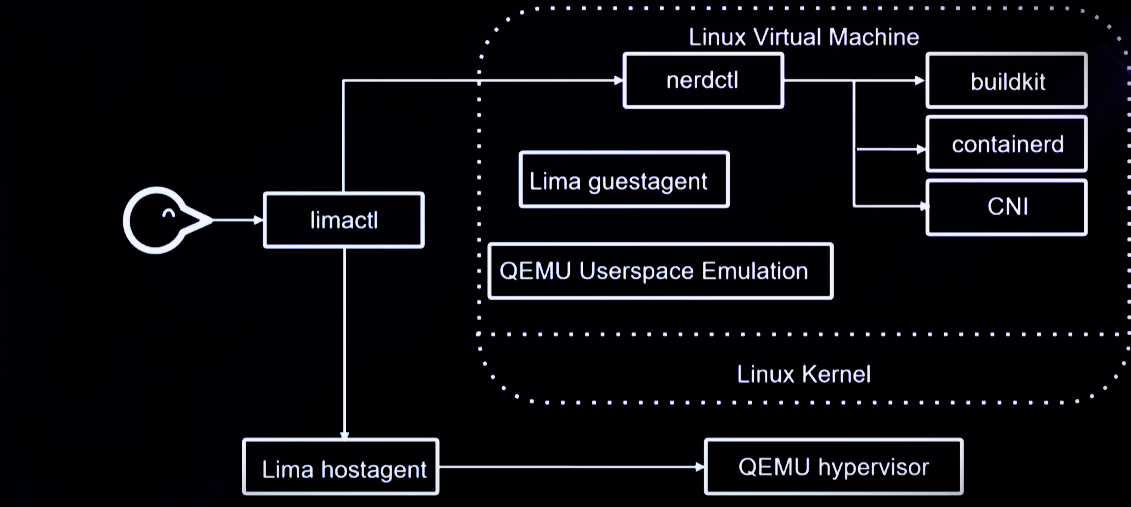Elevate Your Container Game: Simplifying Container Development with Finch
 Arjun Manoj Kumar
Arjun Manoj Kumar
Table of Contents
Introduction
In this blog, we will introduce Finch, based on a session by Akil Mohan on AWS community day Kochi 2023, a software engineer and maintainer of container D, and discuss Finch, an open-source client for container development. We will explore the challenges faced by developers in container development and how Finch aims to simplify the process. The agenda for this blog includes an overview of container development, the hurdles faced by developers, an introduction to Finch, and a discussion on its architecture and components.
Akil Mohan: A software engineer and maintainer of container D
Finch: An open-source client for container development
Challenges in container development: Limited tools for developers on Windows and macOS, the need for Linux VMs, and network setup
Blog agenda: Overview of container development, challenges faced by developers, introduction to Finch, and discussion on its architecture and components
The Era of Containers
In today's software development landscape, containers have become increasingly prevalent. Containers are used to deploy code and applications, and even development environments. They offer several advantages that make them a popular choice for developers.
One of the main advantages of using containers is the ease of code deployment. Containers provide a consistent and reliable environment for running applications, ensuring that the code works the same way across different systems. This eliminates the "it works on my machine" problem and streamlines the deployment process.
Containers also offer significant advantages for development environments. Developers can create containerized environments that include all the necessary tools and dependencies, making it easy to set up and reproduce development environments across different machines. This eliminates the need for developers to spend time installing and configuring tools and reduces the chances of compatibility issues.
However, there are compatibility challenges when it comes to different operating systems. While containers work seamlessly on Linux, Windows, and macOS, there may be some differences in how they are implemented. For example, macOS has limited support for containers due to the limitations of the macOS kernel, making proper isolation difficult.
In the case of macOS, developers often need to set up Linux virtual machines (VMs) to test and run containers. Setting up these VMs can be a time-consuming and complex process. Developers need to create a Linux VM, install container runtimes like Docker or Podman, set up file and network sharing, and ensure proper networking for testing web applications. All these steps can add significant overhead to the initial setup process.
The initial setup process for containers on macOS can have time and cost implications. Developers may spend hours or even days configuring the Linux VM and the necessary tools for container development. This setup process can delay the start of development work and increase the overall development time.
Overall, containers have revolutionized software development by simplifying code deployment and development environments. While they offer many benefits, developers need to navigate compatibility challenges, particularly when working with different operating systems. The need for Linux VMs in macOS adds an additional layer of complexity to the setup process, resulting in potential time and cost implications.
Introducing Finch: A Solution for Container Development
AWS has developed Finch as a solution to address the challenges faced by their developers in container development. Finch is an open-source client that aims to simplify the container development process and provide a more streamlined experience for developers.
Finch offers several key features that make it a valuable tool for container development. Firstly, it provides a single CLI (Command Line Interface) for interacting with containers. This means that developers can use the Finch CLI for almost 90% of the commands they would typically use with Docker on Linux. This unified CLI makes it easier for developers to work with containers, regardless of the operating system they are using.
Another important feature of Finch is its compatibility with different chip architectures, specifically amd64 and arm64. This means that developers can use Finch to launch and work with containers on both Intel and M series chips. This compatibility ensures that developers have flexibility in their container development, regardless of the chip architecture they are working with.
Finch also integrates with other open-source tools to provide a comprehensive container development experience. It leverages containerd, an industry-standard container runtime, to manage the lifecycle of containers on the host machine. Additionally, Finch utilizes Lima, a tool for launching Linux virtual machines on macOS, to provide the necessary Linux environment for testing and running containers. The integration of these tools ensures that developers have access to the essential components required for container development.
The architecture of Finch consists of multiple components working together to facilitate container development. Containerd is used as the container runtime, handling tasks such as storing container layers, launching containers, and managing their lifecycle. Lima provides the Linux virtual machine on macOS, allowing developers to test and run containers in a Linux environment. Buildkit, another component of Finch, is responsible for building container images. It takes Dockerfiles and converts them into various output formats, including Docker tarballs and Open Container Initiative (OCI) tarballs. Lastly, Finch utilizes the Container Networking Interface (CNI) for setting up networking within containers.
In summary, Finch offers a powerful solution for container development by addressing the challenges faced by developers. With its single CLI, compatibility with different chip architectures, integration with open-source tools, and well-designed architecture, Finch simplifies the container development process and provides a streamlined experience for developers.
Architecture:

Components of Finch
Finch, the open-source client for container development, is comprised of several key components that work together to simplify the container development process. These components include:
Containerd
Containerd is an industry-standard container runtime that manages the lifecycle of containers on the host machine. It handles tasks such as storing container layers, launching containers, and managing their lifecycle. Containerd is widely used in various platforms, including Kubernetes and AWS services like EKS Fargate and Firecracker. Finch leverages Containerd to ensure efficient and reliable container management.
Nerdctl
nerdctl is a command-line interface (CLI) for working with container runtimes that provides compatibility with Docker CLI. It allows developers to interact with Containerd directly, giving them full control over their containers. Nerdctl enables developers on macOS or Windows to use familiar Docker commands and seamlessly integrate with the Finch ecosystem.
Lima
Lima is a tool that provides a Linux virtual machine (VM) on macOS. It addresses the challenge of running Linux containers on macOS by creating a Linux environment for testing and running containers. Lima handles the setup of the Linux VM, including file sharing and network configuration. With Lima, developers can easily test and run Linux-based containers on their Mac machines.
Buildkit
Buildkit is a powerful tool used for building container images. It takes Dockerfiles and converts them into various output formats, such as Docker tarballs and Open Container Initiative (OCI) tarballs. Buildkit offers advanced features and optimizations for faster and more efficient container image builds. Finch utilizes Buildkit to streamline the image building process and improve developer productivity.
Installation and Getting Started
To get started with Finch, you can install it using package managers like Homebrew on macOS. Once installed, you need to initialize the Finch VM using the "fin vm init" command. This will start the Linux virtual machine within your macOS environment. From there, you can use the Finch CLI to interact with containers, just like you would with Docker CLI on Linux.
With Finch, you can easily pull container images, run containers, and leverage the various components seamlessly. Finch provides a unified and efficient experience for container development, regardless of the operating system or chip architecture you're using.
Conclusion and FAQ
In conclusion, Finch is an open-source client that aims to simplify container development by addressing the challenges faced by developers. It provides a single CLI for interacting with containers, making it easier for developers working on different operating systems. With its compatibility with different chip architectures and integration with industry-standard tools like containerd and Lima, Finch offers a streamlined and efficient container development experience.
Key points discussed in this blog include:
The advantages of using containers for code deployment and development environments
The challenges faced by developers, especially on Windows and macOS
An introduction to Finch as a solution for container development
The components and architecture of Finch, including containerd, nerdctl, Lima, and buildkit
Frequently Asked Questions:
Is Finch available for use?
Yes, Finch is available as an open-source tool that can be installed using package managers like Homebrew on macOS.
How can I contribute or get further assistance?
If you have any inquiries or want to contribute to Finch, you can contact Akhil Mohan or Arjun Manoj Kumar on platforms like LinkedIn or Twitter. They will be available to provide assistance and guidance related to open-source projects and contributions.
Subscribe to my newsletter
Read articles from Arjun Manoj Kumar directly inside your inbox. Subscribe to the newsletter, and don't miss out.
Written by
